RBF-Based Integrated Optimization Method of Structural and Turning Parameters for Low-Floor Axle Bridge
Abstract
1. Introduction
2. Optimization of Structural Parameters
2.1. Finite Element Simulation
2.2. Parametric Modeling
2.3. Structural Optimization
3. Optimization of Turning Parameters
3.1. Optimization Model of Turning Parameters
3.2. AdvantEdge Turning Simulation
3.3. Optimization Solution
4. Integrated Optimization of Structural and Turning Parameters
4.1. Radial Basis Function
4.2. Multivariate Variance Analysis
4.3. Integrated Optimization Model
4.4. Optimal Latin Hypercube Sampling
4.5. Integrated Optimization Process
4.6. Optimization Solution
5. Conclusions
- (1)
- The optimization of the structural parameters of the axle bridge was conducted. A full factorial experiment with 4-factor and 3-level was designed, from which 64 groups of sample points were randomly selected, and the parametric model was used for simulation. Based on the simulation data, the RBF model was built to fit the implicit relationship between the design variables and the performance responses. In addition, a multi-island genetic algorithm was used for the optimization solution. The total cost was reduced by $47.56 after structural optimization, with a reduction ratio of 8.05%.
- (2)
- Using the optimal structural parameters of the axle bridge, the optimization of the turning parameters of the axle bridge was conducted. An orthogonal experiment with 8-factor and 4-level was designed, whose performance responses were simulated using the 3D turning simulation model built by AdvantEdge software 7.3. Based on simulation data, the RBF model was built to fit the implicit relationship between the turning parameters and performance responses. Finally, a multi-island genetic algorithm was used to solve the optimization model of the process parameter. The total turning cost after optimization was $110.63, which was $4.99 lower than the cost before optimization, with a decrease of 4.316%.
- (3)
- The integrated optimization of the structural and turning parameters was conducted. By combining orthogonal experiments and multivariate variance analysis, design variables that have great impacts on the performance responses were selected. The optimal Latin hypercube experiment and simulation were then used to select 60 groups of sample points, which were used to build the RBF model to fit the implicit relationship between design variables and performance responses. Finally, a multi-island genetic algorithm was used to solve the integrated optimization model. Through verifying tests, the total cost after integrated optimization was $646.65, which was 8.457% lower than the total cost before optimization, and 1.1% lower than the total cost of sequential optimization, proving the effectiveness of the proposed method.
- (4)
- Through the integrated optimization, the total cost of the axle bridge structure and turning is reduced. The proposed method can also be used in structural and machining process optimization for other products, which provides theoretical insights for enterprises to reduce manufacturing costs and enhance product competitiveness. However, in practical applications, there may be deviations in manufacturing costs among different companies for the same product (e.g., due to variations in labor hours), and raw material prices may fluctuate over time. Therefore, in future research, consideration will be given to these uncertainties during the optimization process, further enhancing the practical effectiveness of the integrated optimization method.
Author Contributions
Funding
Data Availability Statement
Conflicts of Interest
References
- Brinkmann, A.; Jenne, S.; Kasprzyk, T. Next generation of wheelsets and independent wheel axles for advanced low-floor Light Rail Vehicles (LRV). In Proceedings of the International Wheelset Congress, Chengdu China, 7–10 November 2016. [Google Scholar]
- Qu, S.; Zhao, J.; Wang, T. Experimental study and machining parameter optimization in milling thin-walled plates based on NSGA-II. Int. J. Adv. Manuf. Technol. 2016, 89, 2399–2409. [Google Scholar] [CrossRef]
- Tian, C.; Zhou, G.; Lu, F.; Chen, Z.; Zou, L. An integrated multi-objective optimization approach to determine the optimal feature processing sequence and cutting parameters for carbon emissions savings of CNC machining. Int. J. Comput. Integr. Manuf. 2019, 33, 609–625. [Google Scholar] [CrossRef]
- Yang, Q.; Yin, R.; Li, C.; Feng, X. An Optimization Model of Cutting Path and Parameters for Low Cost and Carbon Emissions in a NC Milling Process; IOP Publishing Ltd.: Bristol, UK, 2022. [Google Scholar] [CrossRef]
- Pourmostaghimi, V.; Zadshakoyan, M.; Badamchizadeh, M.A. Intelligent model-based optimization of cutting parameters for high quality turning of hardened AISI D2. Artif. Intell. Eng. Des. Anal. Manuf. 2020, 34, 421–429. [Google Scholar] [CrossRef]
- Qu, S.; Yao, P.; Gong, Y.; Chu, D.; Yang, Y.; Li, C.; Wang, Z.; Zhang, X.; Hou, Y. Environmentally friendly grinding of C/SiCs using carbon nanofluid minimum quantity lubrication technology. J. Clean. Prod. 2022, 366, 132898. [Google Scholar] [CrossRef]
- Li, C.; Li, X.; Wu, Y.; Zhang, F.; Huang, H. Deformation mechanism and force modelling of the grinding of YAG single crystals. Int. J. Mach. Tools Manuf. 2019, 143, 23–37. [Google Scholar] [CrossRef]
- Gupta, P.K.; Agrawal, S.; Ghosh, G.; Kumar, V.; Paramasivam, P. Seismic behaviour of the curved bridge with friction pendulum system. J. Asian Archit. Build. Eng. 2023, 1–14. [Google Scholar] [CrossRef]
- Gupta, P.K.; Ghosh, G.; Kumar, V.; Paramasivam, P.; Dhanasekaran, S. Effectiveness of LRB in curved bridge isolation: A numerical study. Appl. Sci. 2022, 12, 11289. [Google Scholar] [CrossRef]
- Zhou, Q.; Yang, Y.; Song, X.; Han, Z.; Cheng, Y.; Hu, J.; Shu, L.; Jiang, P. Survey of multi-fidelity surrogate models and their applications in the design and optimization of engineering equipment. J. Mech. Eng. 2020, 56, 219–245. [Google Scholar]
- Marimuthu, P.; Durakovic, B.; Kunda, S.R. Modelling the effect of feed rate on residual stresses induced due to milling using experimental and numerical methods. Period. Eng. Nat. Sci. 2021, 9, 76–81. [Google Scholar] [CrossRef]
- Yufei, W.U.; Teng, L.; Renhe, S.; Gary, W.G. A Rapid Mode Pursuing Sampling Method for High Dimensional Optimization Problems. J. Mech. Eng. 2019, 55, 138–146. [Google Scholar] [CrossRef]
- Gao, X.; Hou, H.; Huang, L.; Yu, G.; Chen, C. Evaluation of Kriging-NARX Modeling for Uncertainty Quantification of Nonlinear SDOF Systems with Degradation. Int. J. Struct. Stab. Dyn. 2021, 21, 2150060. [Google Scholar] [CrossRef]
- An, Z.G.; Zhou, J.; Zhao, J.; Zhang, Y. Simulation Research for Sheet Metal Forming Process Based on Response Surface Methodology of Radius Basis Function. J. Syst. Simul. 2009, 16, 183–189. [Google Scholar] [CrossRef]
- Wei, Z.; Tao, T.; ZhuoShu, D.; Zio, E. A dynamic particle filter-support vector regression method for reliability—ScienceDirect. Reliab. Eng. Syst. Saf. 2013, 119, 109–116. [Google Scholar] [CrossRef]
- Wang, L.; Zhao, X.; Li, J. Optimization of gear grinding parameters with worm grinding wheel. China Mech. Eng. 2021, 32, 2136. [Google Scholar] [CrossRef]
- Wang, P.-J.; Li, L.; Wu, J.-B. Research on the lightweight structural optimization design of the front collector of the polymetallic nodule miner. Ocean Eng. 2023, 267, 113275. [Google Scholar] [CrossRef]
- Gao, Z.; Shao, X.; Jiang, P.; Cao, L.; Zhou, Q.; Yue, C.; Liu, Y.; Wang, C. Parameters optimization of hybrid fiber laser-arc butt welding on 316L stainless steel using Kriging model and GA. Opt. Laser Technol. 2016, 83, 153–162. [Google Scholar] [CrossRef]
- Wang, D.; Xie, C.; Liu, Y.; Xu, W.; Chen, Q. Multi-objective collaborative optimization for the lightweight design of an electric bus body frame. Automot. Innov. 2020, 3, 250–259. [Google Scholar] [CrossRef]
- Li, X.; Yan, F.; Ma, J.; Chen, Z.; Wen, X.; Cao, Y. RBF and NSGA-II based EDM process parameters optimization with multiple constraints. Math. Biosci. Eng. 2019, 16, 5788–5803. [Google Scholar] [CrossRef] [PubMed]
- Gao, Y.; Liu, Q.; Wang, Y.; Zhao, W. Lightweight design with weld fatigue constraints for a three-axle bogie frame using sequential approximation optimisation method. Int. J. Veh. Des. 2017, 73, 3–19. [Google Scholar] [CrossRef]
- Dai, Z. Strength analysis and structural design of the axle-bridge for 100% low-floor tram. Technol. Mark. 2021, 28, 1–4+7. [Google Scholar]
- TB/T 3549.1-2019; Strength Design and Test Accreditation Specification for Rolling Stock—Bogie—Part 1: Bogie Frame. National Railway Administration of PRC: Beijing, China, 2019; pp. 1–26.
- Chen, L.; Chen, W.; Huang, Q. Effect of ultrasonic vibration on quality and properties of laser EA4T steel. J. Mater. Eng. 2019, 47, 79–85. [Google Scholar]
- Mellal, M.A.; Williams, E.J. Cuckoo optimization algorithm for unit production cost in multi-pass turning operations. Int. J. Adv. Manuf. Technol. 2015, 76, 647–656. [Google Scholar] [CrossRef]
- Vijayakumar, K.; Prabhaharan, G.; Asokan, P.; Saravanan, R. Optimization of multi-pass turning operations using ant colony system. Int. J,. Mach. Tools Manuf. 2003, 43, 1633–1639. [Google Scholar] [CrossRef]
- Elbestawi, M. Metal cutting theory and practice. Mach. Sci. Technol. 1998, 2, 383–384. [Google Scholar] [CrossRef]
- Yu, X.; Xu, T.; Wang, J. Sound Velocity Profile Prediction Method Based on RBF Neural Network. In Proceedings of the 11th China Satellite Navigation Annual Conference, Chengdu, China, 23–25 November 2020. [Google Scholar] [CrossRef]
- Lan, F.; Zhou, J.; Lai, F.; Chen, J. Lightweight Design of BIW Based on Radial Basis Function Neural Networks. Mech. Des. Manuf. 2018, 8, 29–32. [Google Scholar] [CrossRef]
- Li, X.; Zhu, H.; Chen, Z.; Ming, W.; Cao, Y.; He, W.; Ma, J. Limit state Kriging modeling for reliability-based design optimization through classification uncertainty quantification. Reliab. Eng. Syst. Saf. 2022, 224, 108539. [Google Scholar] [CrossRef]
- Liu, X. Construction and application of multivariate analysis of variance model. Stat. Decis. Mak. 2019, 35, 75–78. [Google Scholar] [CrossRef]
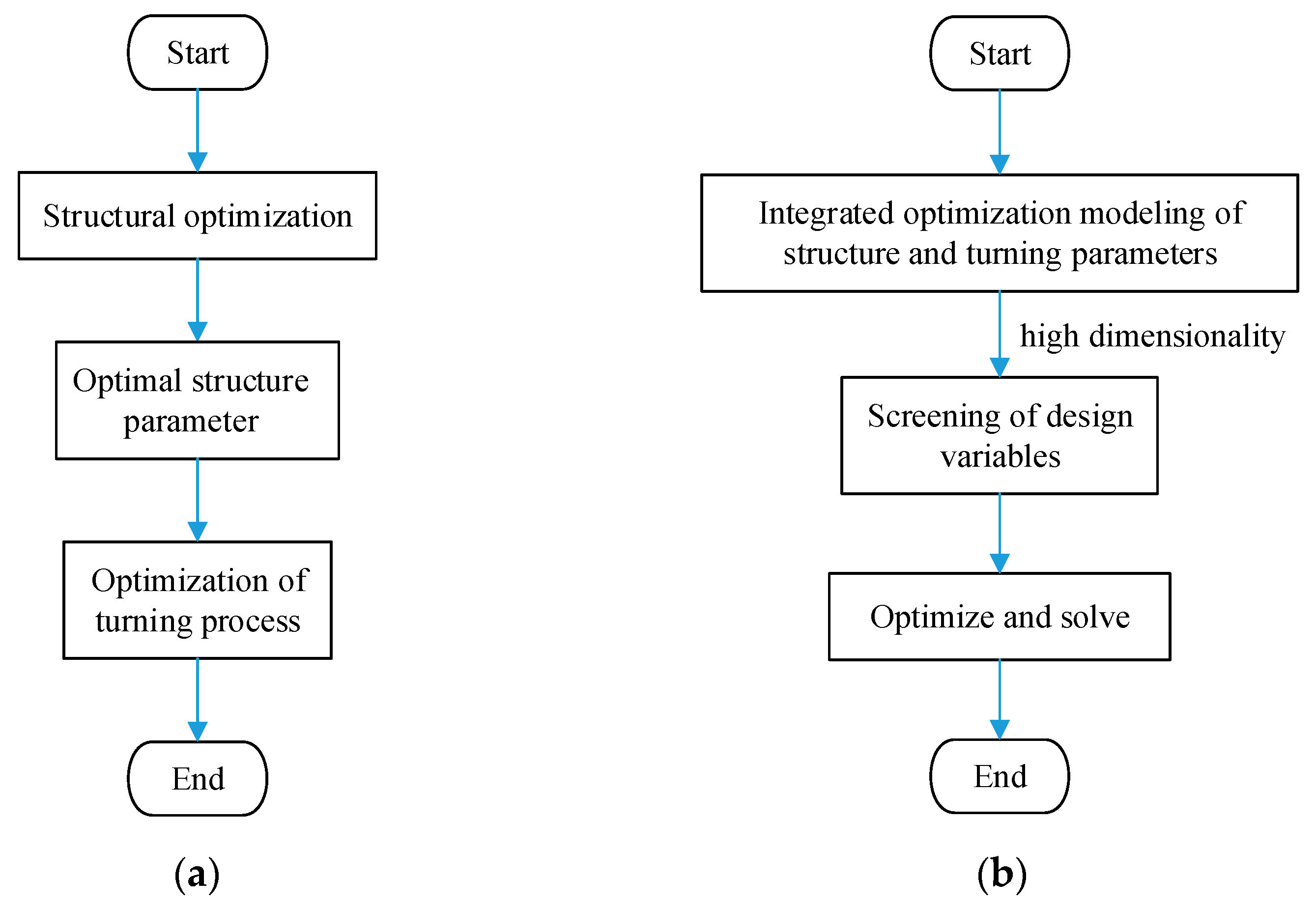
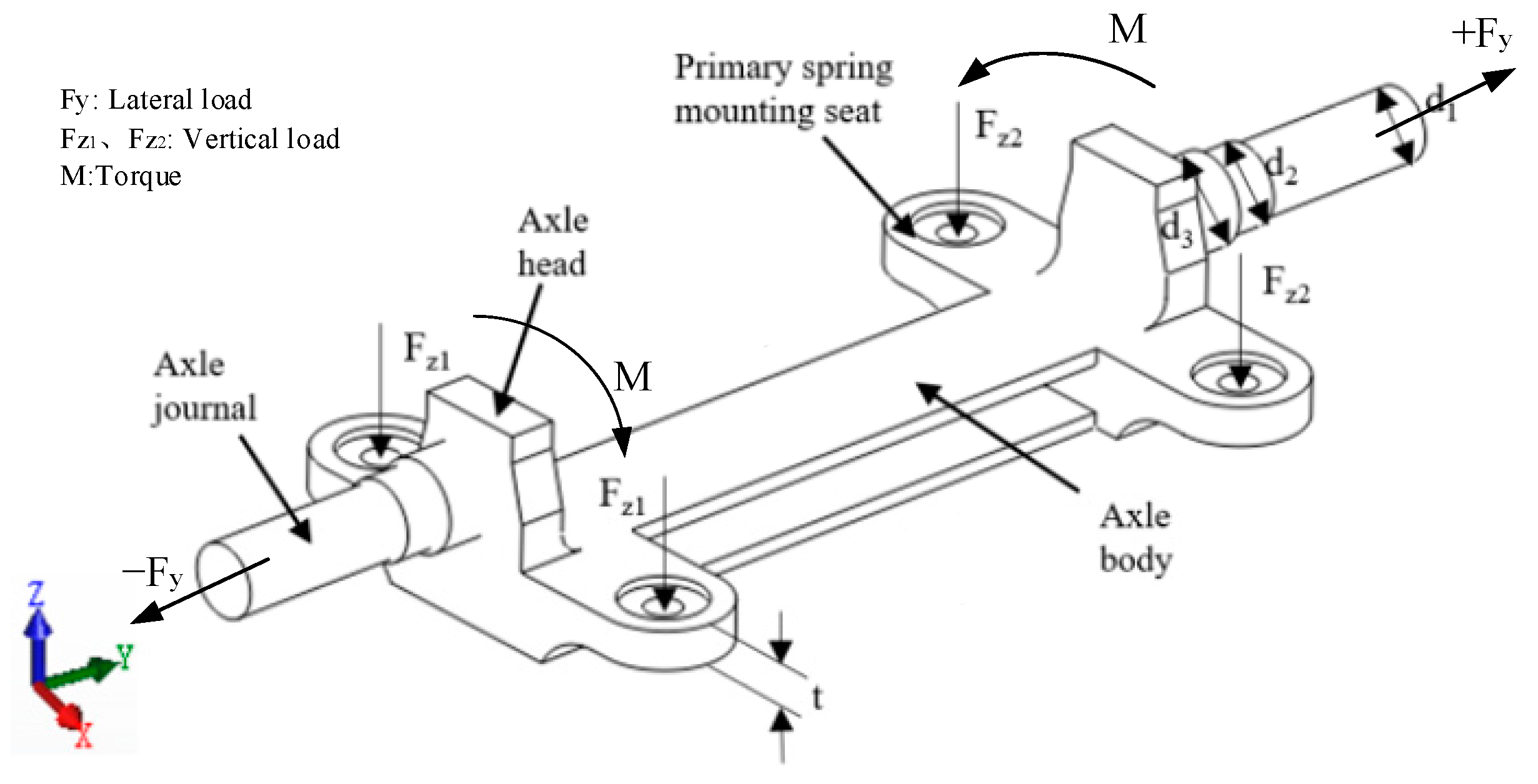
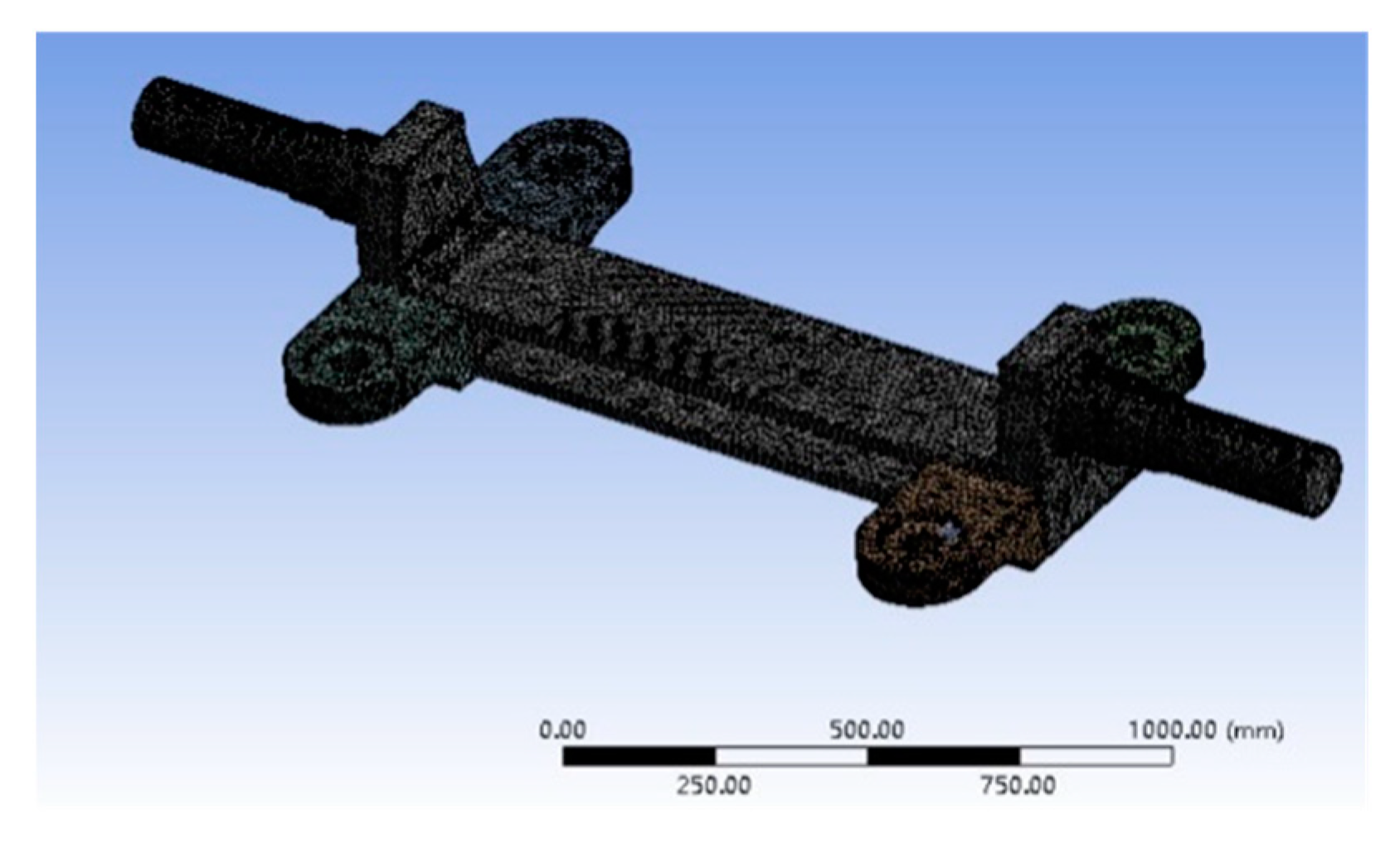
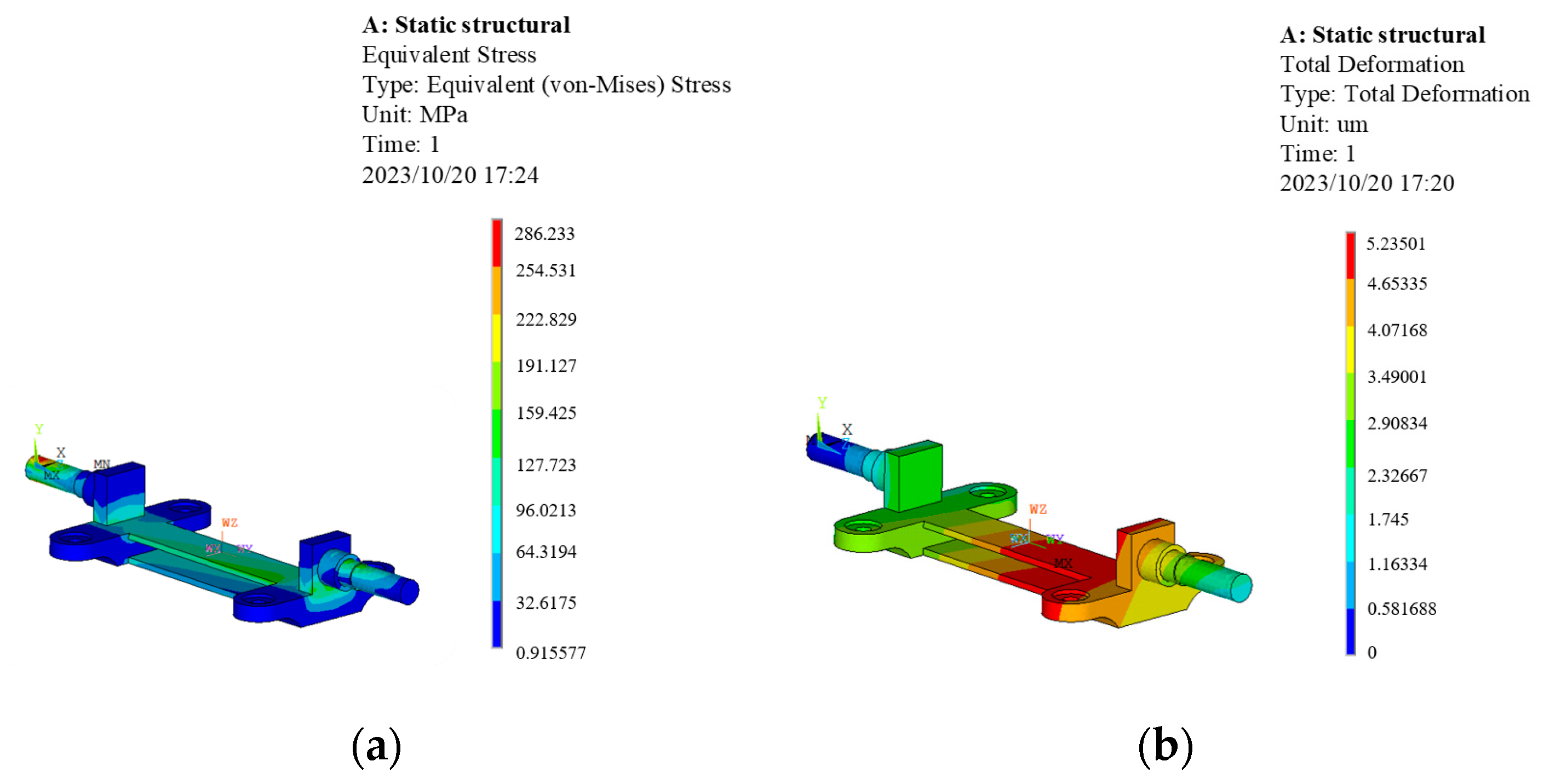

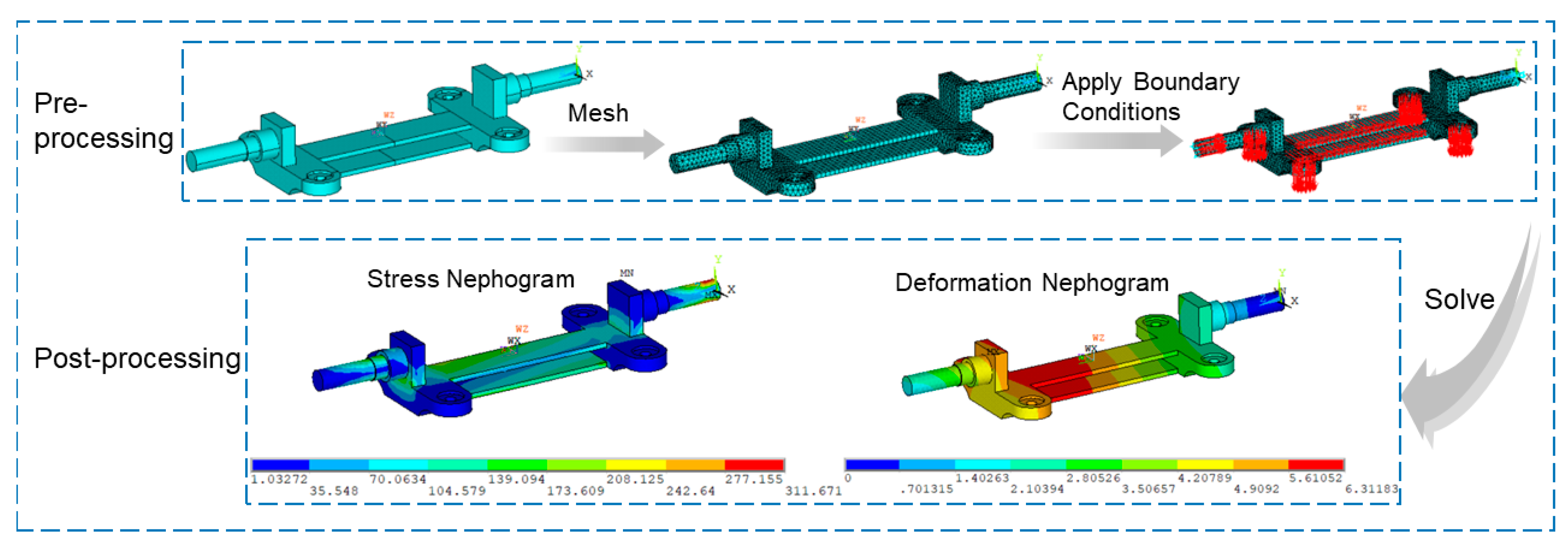


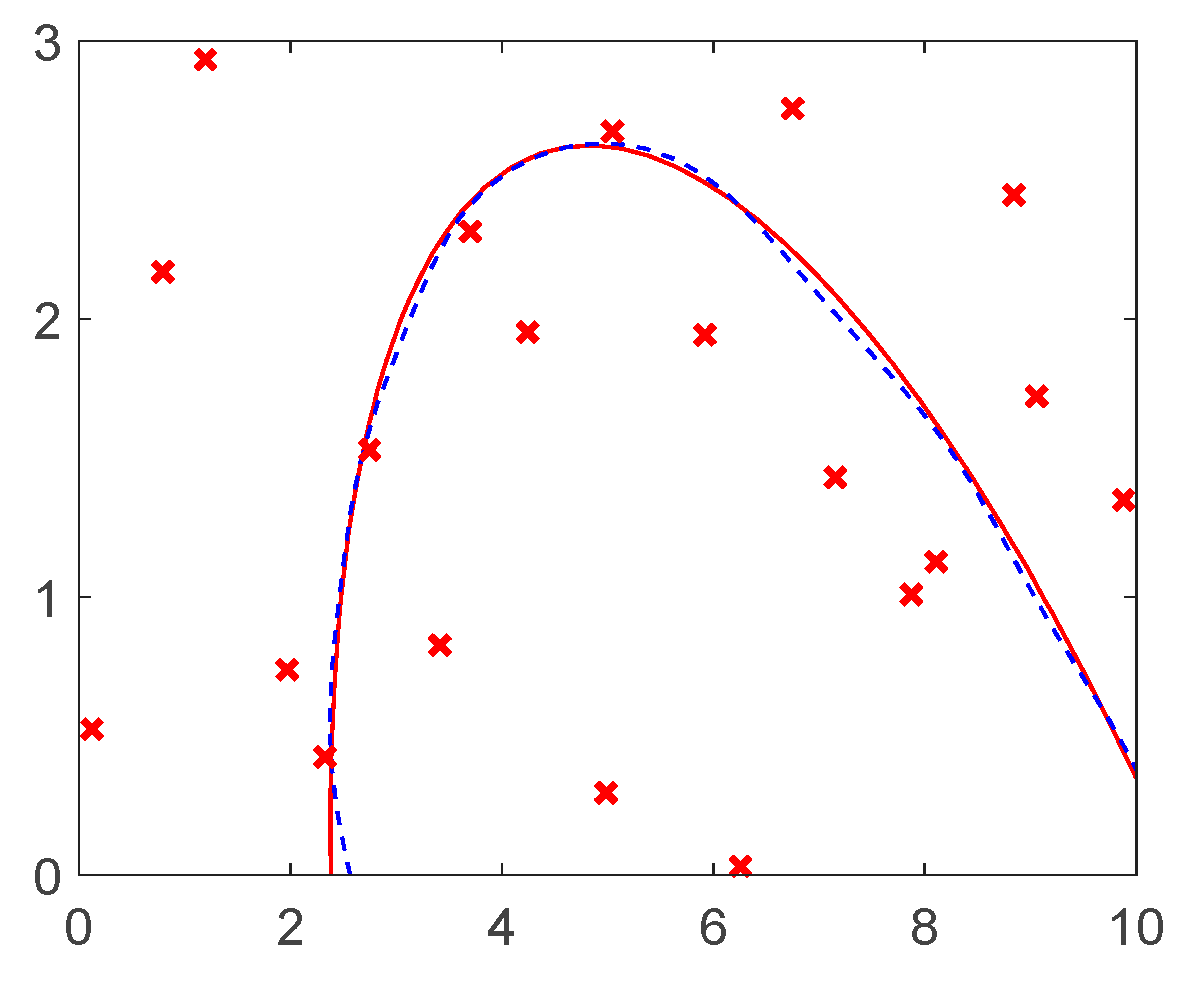
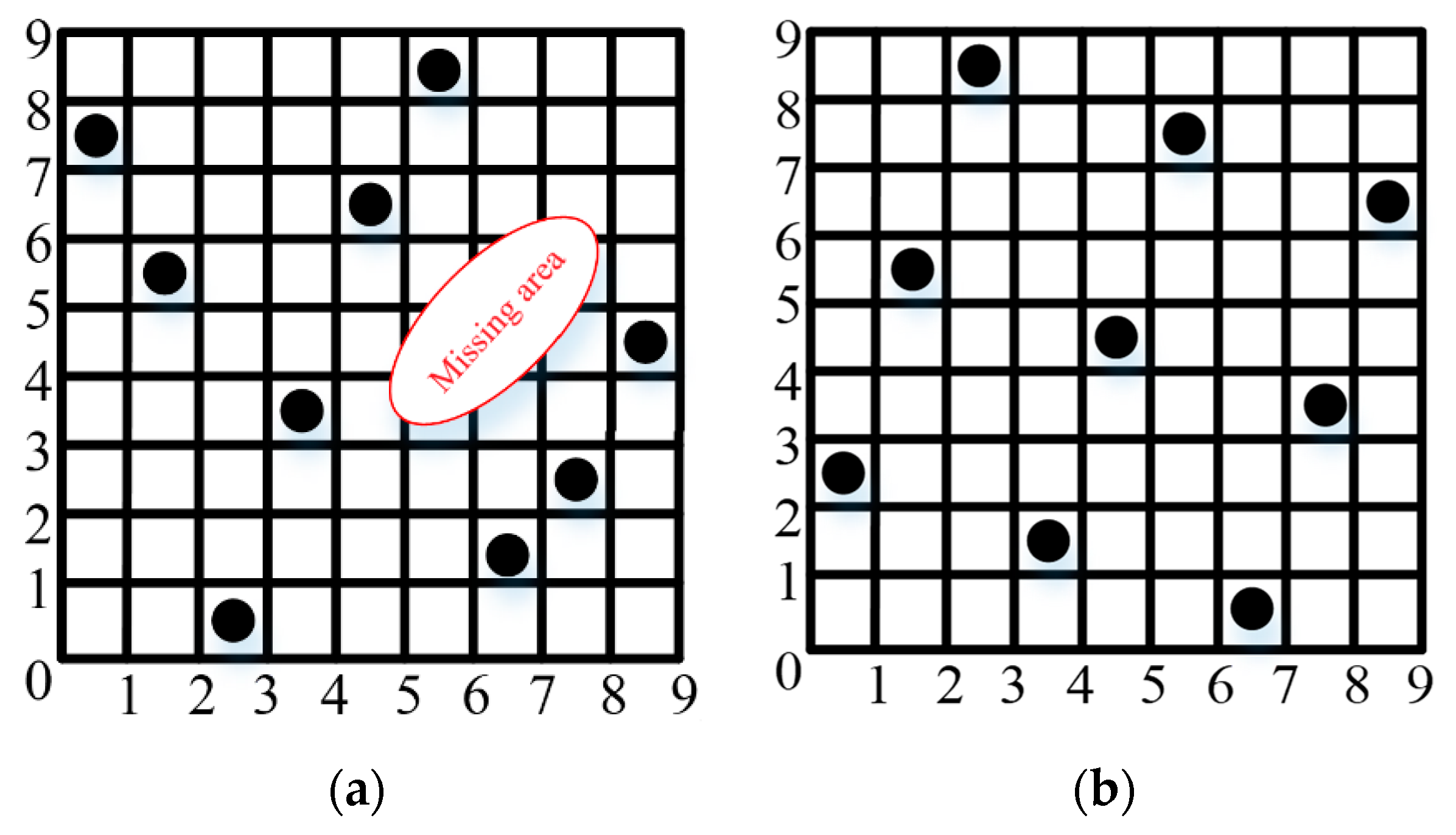



| Unit | Name | Value | |
|---|---|---|---|
| Mv | kg | Vehicle mass | 10,200 |
| m+ | kg | Bogie mass | 5400 |
| p | kg | Normal passenger capacity | 6240 |
| g | m/s2 | Gravitational acceleration | 9.81 |
| Tensile Strength (MPa) | Yield Strength (MPa) | Elastic Modulus (MPa) | Poisson’s Ratio | Density (kg/m3) |
|---|---|---|---|---|
| 678 | ≥420 | 2.05 × 105 | 0.28 | 7850 |
| Design Variable | Value Range | Initial Value |
|---|---|---|
| Diameter of the first section journal ×1 (mm) | [110, 130] | 120 |
| Diameter of the second section journal ×2 (mm) | [120, 140] | 133 |
| Diameter of the third section journal ×3 (mm) | [140, 160] | 153 |
| Thickness of spring seat ×4 (mm) | [50, 70] | 60 |
| No. | Design Variable | Performance Response | ||||||
|---|---|---|---|---|---|---|---|---|
| x1 | x2 | x3 | x4 | Blank Cost | Maximum Stress | Maximum Deformation | Minimum Life | |
| (mm) | ($) | (MPa) | (10−3 mm) | (Times) | ||||
| 1 | 110 | 130 | 160 | 50 | 546.94 | 331.365 | 9.106 | 5.22 × 108 |
| 2 | 120 | 140 | 160 | 50 | 560.93 | 328.764 | 6.010 | 2.24 × 100 |
| 3 | 120 | 130 | 140 | 60 | 570.96 | 286.491 | 3.225 | 9.13 × 1012 |
| 4 | 110 | 140 | 160 | 50 | 550.08 | 344.752 | 11.200 | 8.14 × 107 |
| 5 | 120 | 130 | 150 | 60 | 575.59 | 281.54 | 4.161 | 2.16 × 1012 |
| 6 | 110 | 130 | 150 | 60 | 564.73 | 288.221 | 9.259 | 7.11 × 108 |
| 7 | 120 | 130 | 160 | 70 | 603.28 | 250.875 | 5.018 | 3.23 × 1012 |
| 8 | 110 | 130 | 150 | 70 | 587.47 | 260.510 | 9.291 | 7.08 × 108 |
| … | … | … | … | … | … | … | … | … |
| 64 | 110 | 120 | 160 | 50 | 544.03 | 325.990 | 4.466 | 9.04 × 109 |
| Design Variable | d1 (mm) | d2 (mm) | d3 (mm) | t (mm) |
|---|---|---|---|---|
| Before optimization | 120 | 133 | 153 | 60 |
| After optimization | 110.04 | 123.29 | 151.71 | 50.921 |
| Design Variables | Value Range | Initial Value |
|---|---|---|
| Cutting speed for rough machining ×1 (m/min) | [80, 150] | 115 |
| Feeding speed for rough machining ×2 (mm/r) | [0.5, 0.8] | 0.65 |
| Cutting speed during semiprecision machining ×3 (m/min) | [180, 200] | 190 |
| Feeding speed during semiprecision machining ×4 (mm/r) | [0.3, 0.5] | 0.4 |
| Depth of cut during semiprecision machining ×5 (mm) | [0.8, 2] | 1.4 |
| Cutting speed during precision machining ×6 (m/min) | [220, 235] | 227.5 |
| Feeding speed during precision machining ×7 (mm/r) | [0.1, 0.3] | 0.2 |
| Depth of cut during precision machining ×8 (mm) | [0.2, 1] | 0.6 |
| Parameters | Values | Parameters | Values (mm) |
|---|---|---|---|
| 35 min | 380 | ||
| 15 min | 305 | ||
| 5 $/blade | 75 | ||
| 2.5 $/min | 10 | ||
| 25 min |
| Parameters | Values | Parameters | Values |
|---|---|---|---|
| Cutting Method | 3D External Turning | Workpiece Diameter (D) | 8 mm |
| Workpiece Length (L) | 4 mm | Workpiece material | 25 CrMo4 |
| Tool shape | Rhombus | Back rake angle | 0° |
| Side rake angle | −5° | Front clearance angle | −25° |
| Major cutting-edge angle | 90° | Tool tip radius | 0.4 mm |
| Tool material | Carbide-General | Tool coating material | TiAlN |
| thickness | 0.005 mm |
| No. | x1 | x2 | x3 | x4 | x5 | x6 | x7 | x8 | FC1 | FC2 | FC3 | f(x) |
|---|---|---|---|---|---|---|---|---|---|---|---|---|
| 1 | 80 | 0.5 | 180 | 0.3 | 0.8 | 220 | 0.1 | 0.2 | 3487.08 | 1154.42 | 151.011 | 1416.113 |
| 2 | 100 | 0.8 | 180 | 0.3 | 1.2 | 235 | 0.25 | 0.5 | 5194.55 | 1516.73 | 532.188 | 788.662 |
| 3 | 150 | 0.5 | 180 | 0.35 | 1.6 | 225 | 0.25 | 1 | 3568.04 | 2268.77 | 1059.06 | 738.875 |
| 4 | 125 | 0.8 | 180 | 0.35 | 2 | 230 | 0.1 | 0.3 | 4592.23 | 2507.41 | 191.173 | 1113.071 |
| 5 | 125 | 0.6 | 180 | 0.4 | 0.8 | 235 | 0.15 | 1 | 3827.83 | 1497.79 | 689.17 | 777.732 |
| 6 | 150 | 0.7 | 180 | 0.4 | 1.2 | 220 | 0.3 | 0.3 | 4561.46 | 1962.6 | 318.087 | 826.584 |
| 7 | 100 | 0.6 | 180 | 0.5 | 1.6 | 230 | 0.3 | 0.2 | 3705.94 | 3065.46 | 330.981 | 908.317 |
| 8 | 80 | 0.7 | 180 | 0.5 | 2 | 225 | 0.15 | 0.5 | 4166.67 | 3308.97 | 381.564 | 872.050 |
| 9 | 150 | 0.7 | 187 | 0.3 | 1.6 | 235 | 0.15 | 0.2 | 4247.22 | 1968.68 | 198.979 | 1104.153 |
| 10 | 125 | 0.6 | 187 | 0.3 | 2 | 220 | 0.3 | 0.5 | 4133.8 | 2063.03 | 683.916 | 774.064 |
| … | … | … | … | … | … | … | … | … | … | … | … | … |
| 32 | 150 | 0.8 | 200 | 0.5 | 2 | 235 | 0.3 | 1 | 5203.67 | 3541.95 | 1287.64 | 708.977 |
| Variable | x1 (m/min) | x2 (mm/r) | x3 (mm) | x4 (m/min) | x5 (mm/r) | x6 (m/min) | x7 (mm/r) | x8 (mm) |
|---|---|---|---|---|---|---|---|---|
| Before optimization | 115 | 0.65 | 190 | 0.4 | 1.4 | 227.5 | 0.2 | 0.6 |
| After optimization | 118 | 0.7458 | 184.9 | 0.3451 | 1.4687 | 227.76 | 0.2443 | 0.5207 |
| Level 1 | 110 | 120 | 140 | 50 | 80 | 0.5 | 180 | 0.3 | 0.8 | 220 | 0.1 | 0.2 |
| Level 2 | 117 | 127 | 147 | 57 | 100 | 0.6 | 187 | 0.3 | 0.8 | 225 | 0.15 | 0.3 |
| Level 3 | 124 | 134 | 154 | 64 | 125 | 0.7 | 194 | 0.4 | 1.6 | 230 | 0.25 | 0.5 |
| Level 4 | 130 | 140 | 160 | 70 | 150 | 0.8 | 200 | 0.5 | 2 | 235 | 0.3 | 1 |
| No. | Design Variable | Response | ||||
|---|---|---|---|---|---|---|
| Structure Parameters ) | Turning Parameters ) | Blank Cost ($), Stress (MPa) Deformation (10−3 mm), Life (Times) | FC1 (N) | FC2 (N) | FC3 (N) | |
| 1 | 124, 140 154, 50 | 125, 0.7, 180, 0.3, 1.2, 225, 0.25, 1 | 562.53, 309.363, 6.237 1.48 × 107 | 1516.73 | 3723.56 | 1059.06 |
| 2 | 130, 134 147, 70 | 150, 0.6, 200, 0.4, 1.6, 235, 0.25, 0.2 | 609.93, 328.198, 6.297 5.8 × 107 | 2286.1 | 3886.51 | 349.649 |
| 3 | 124, 140 154, 57 | 100, 0.8, 194, 0.35, 1.6, 230, 0.25, 0.2 | 578.45, 311.924, 6.219 1.48 × 107 | 880.815 | 5194.55 | 423.531 |
| 4 | 124, 127 160, 70 | 100, 0.5, 180, 0.4, 1.2, 220, 0.15, 1 | 606.99, 315.039, 6.208 1.59 × 107 | 1962.6 | 3767.96 | 658.867 |
| 5 | 124, 134 160, 64 | 80, 0.8, 187, 0.35, 2, 225, 0.1, 0.3 | 595.47, 318.499, 6.179 1.58 × 107 | 2342.86 | 4018.12 | 196.11 |
| 6 | 130, 140 140, 57 | 100, 0.5, 194, 0.5, 0.8, 235, 0.1, 0.5 | 588.65, 323.065, 6.426 5.46 × 107 | 1733.97 | 3767.96 | 374.606 |
| 7 | 124, 127 160, 64 | 125, 0.6, 194, 0.5, 1.6, 235, 0.15, 0.2 | 593.34, 313.538, 6.2116 1.58 × 107 | 3041.92 | 3827.83 | 198.979 |
| 8 | 124, 134 160, 70 | 150, 0.7, 200, 0.3, 0.8, 230, 0.1, 0.5 | 609.11, 315.716, 6.17 1.59 × 107 | 1066.37 | 4247.22 | 292.187 |
| … | … | … | … | … | … | … |
| 49 | 130, 140 160, 70 | 150, 0.8, 200, 0.5, 2, 235, 0.3, 1 | 618.21, 326.137, 6.162 4.13 × 107 | 3541.95 | 4210.54 | 1287.64 |
| Optimization Object | p (Blank Cost) | p (Stress) | p (Deformation) | p (FC2) | p (FC3) | p (Turning Cost) |
|---|---|---|---|---|---|---|
| 0.000 ** | 0.000 ** | 0.006 ** | — | — | — | |
| 0.000 ** | 0.557 | 0.003 ** | — | — | — | |
| 0.000 ** | 0.047 * | 0.001 ** | — | — | — | |
| 0.000 ** | 0.675 | 0.008 ** | — | — | — | |
| 0.000 ** | — | — | 0.284 | — | 0.752 | |
| — | — | — | 0.000 ** | — | 0.279 | |
| — | — | — | 0.000 ** | — | 0.906 | |
| — | — | — | — | — | 0.825 | |
| — | — | — | — | — | 0.767 | |
| — | — | — | — | 0.997 | 0.945 | |
| — | — | — | — | 0.004 ** | 0.000 ** | |
| — | — | — | — | 0.000 ** | 0.000 ** |
| No. | Blank Cost ($) | Stress (MPa) | Deformation (10−3 mm) | Life (Times) | Cutting Force (N) | Total Cost ($) | |
|---|---|---|---|---|---|---|---|
| 1 | 121.35, 127.57, 154.59, 58.92, 0.1, 0.589 | 576.17 | 308.461 | 6.274 | 9.82 × 106 | 330.438 | 676.355 |
| 2 | 128.11, 138.92, 154.05, 64.05, 0.132, 0.73 | 599.05 | 320.797 | 6.222 | 6.41 × 107 | 465.454 | 701.416 |
| 3 | 121.35, 130.27, 148.39, 58.11, 0.297, 0.232 | 572.14 | 309.701 | 6.317 | 9.74 × 106 | 381.504 | 674.949 |
| 4 | 124.86, 135.68, 156.22, 54.32, 0.268, 0.914 | 573.08 | 313.908 | 6.219 | 3.74 × 107 | 1035.92 | 675.163 |
| 5 | 115.14, 132.16, 153.51, 65.95, 0.222, 0.2 | 586.08 | 338.994 | 6.276 | 5.63 × 106 | 323.932 | 686.018 |
| 6 | 114.86, 128.92, 143.24, 67.03, 0.287, 0.449 | 582.39 | 344.813 | 6.414 | 3.71 × 106 | 667.398 | 682.821 |
| 7 | 117.03, 1274.3, 158.11, 52.43, 0.154, 0.924 | 558.23 | 329.541 | 6.275 | 8.01 × 106 | 651.253 | 660.062 |
| 8 | 112.43, 129.19, 157.84, 69.46, 0.251, 0.654 | 592.40 | 307.256 | 6.235 | 2.07 × 107 | 792.161 | 692.223 |
| 9 | 115.41, 140, 145.14, 60.27, 0.260, 0.33 | 571.95 | 345.105 | 6.334 | 3.97 × 106 | 396.776 | 671.198 |
| 10 | 114.32, 125.95, 146.76, 58.65, 0.116, 0.265 | 563.50 | 294.359 | 6.369 | 2.35 × 107 | 188.412 | 664.645 |
| …… | …… | …… | …… | …… | …… | …… | …… |
| 60 | 115.68, 131.35, 140.27, 67.84, 0.214, 0.87 | 584.51 | 343.689 | 6.42129 | 4.47 × 106 | 783.644 | 684.693 |
| Design Variables | (mm) | (mm) | (mm) | (mm) | (mm/r) | |
|---|---|---|---|---|---|---|
| Before optimization | 120 | 133 | 153 | 60 | 0.2 | 0.6 |
| After optimization | 111.98 | 128.66 | 156.93 | 50.043 | 0.14175 | 0.69155 |
| Blank Cost ($) | Stress (MPa) | Deformation (10−3 mm) | Main Cutting Force (N) | Total Cost ($) | |
|---|---|---|---|---|---|
| Before optimization | 590.77 | 281.540 | 5.761 | 539.919 | 706.392 |
| After sequential optimization | 543.75 | 313.408 | 6.295 | 580.458 | 653.843 |
| After integrated optimization | 547.16 | 306.415 | 6.29572 | 469.704 | 646.65 |
Disclaimer/Publisher’s Note: The statements, opinions and data contained in all publications are solely those of the individual author(s) and contributor(s) and not of MDPI and/or the editor(s). MDPI and/or the editor(s) disclaim responsibility for any injury to people or property resulting from any ideas, methods, instructions or products referred to in the content. |
© 2024 by the authors. Licensee MDPI, Basel, Switzerland. This article is an open access article distributed under the terms and conditions of the Creative Commons Attribution (CC BY) license (https://creativecommons.org/licenses/by/4.0/).
Share and Cite
Li, X.; Xing, W.; Jiang, Q.; Chen, Z.; Zhao, W.; Xu, Y.; Cao, Y.; Ming, W.; Ma, J. RBF-Based Integrated Optimization Method of Structural and Turning Parameters for Low-Floor Axle Bridge. Metals 2024, 14, 273. https://doi.org/10.3390/met14030273
Li X, Xing W, Jiang Q, Chen Z, Zhao W, Xu Y, Cao Y, Ming W, Ma J. RBF-Based Integrated Optimization Method of Structural and Turning Parameters for Low-Floor Axle Bridge. Metals. 2024; 14(3):273. https://doi.org/10.3390/met14030273
Chicago/Turabian StyleLi, Xiaoke, Wenbo Xing, Qianlong Jiang, Zhenzhong Chen, Wenbo Zhao, Yapeng Xu, Yang Cao, Wuyi Ming, and Jun Ma. 2024. "RBF-Based Integrated Optimization Method of Structural and Turning Parameters for Low-Floor Axle Bridge" Metals 14, no. 3: 273. https://doi.org/10.3390/met14030273
APA StyleLi, X., Xing, W., Jiang, Q., Chen, Z., Zhao, W., Xu, Y., Cao, Y., Ming, W., & Ma, J. (2024). RBF-Based Integrated Optimization Method of Structural and Turning Parameters for Low-Floor Axle Bridge. Metals, 14(3), 273. https://doi.org/10.3390/met14030273










